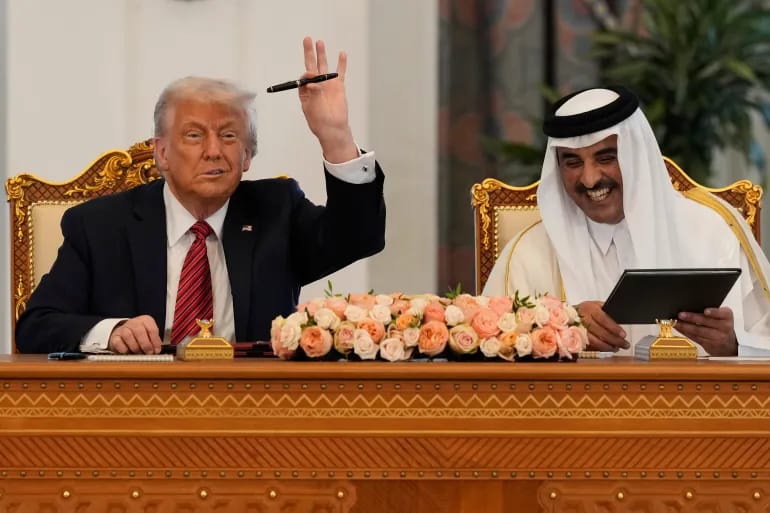
The White House claims that President Donald Trump returned from Riyadh, Doha, and Abu Dhabi with more than $2 trillion in prospective business, highlighted by a $600 billion Saudi pledge to invest in the United States, a $1.2 trillion “economic exchange” framework with Qatar, and a further $200 billion in commercial accords with the United Arab Emirates. (The White House, The White House) At first glance those numbers eclipse every prior U.S. trade mission to the Gulf. The real question is how much of the fanfare will translate into binding contracts, export shipments, and net new jobs.
Reality check on the headline figures. Gulf governments routinely blend signed purchase contracts with letters of intent and multiyear memoranda of understanding. A reconciliation of public filings and press releases by Reuters suggests that hard commitments total closer to $700 billion, with the balance dependent on feasibility studies, congressional approvals, and future budget cycles. (Reuters, Reuters) The contrast is instructive: the celebrated $110 billion Saudi arms package announced in 2017 ultimately yielded roughly $25 billion in executed foreign‑military‑sales contracts.
Who gains first? Commercial‑aircraft and defense primes stand at the front of the line. Qatar’s provisional order for up to 210 Boeing wide‑bodies carries a nominal list price near $96 billion, while Saudi Arabia’s new arms tranche earmarks roughly $142 billion for fighters, missile defense, and command‑and‑control systems. (Bloomberg, Reuters) Investors have already priced in some of the upside: Boeing and Lockheed Martin both rose about five percent over the two sessions that followed the announcements, handily outpacing the S&P 500.
Technology and energy spill‑overs. Abu Dhabi’s ten‑year, $1.4 trillion investment framework centers on advanced‑computing infrastructure and promises to funnel hundreds of thousands of Nvidia AI chips to Emirati data centers each year. The deal dovetails with the UAE’s ambition to position itself as a global AI hub while remaining inside Washington’s export‑control perimeter. (Reuters, Arab News) In energy, Emirati and Saudi sovereign funds pledged to expand stakes in U.S. LNG, hydrogen, and critical‑minerals projects—support that could backstop long‑cycle capital spending in America’s industrial heartland.
Macroeconomic lift at home. If even half of the nominal deal value turns into delivered goods, the Commerce Department’s export ledger would register the largest single‑region surge since the early‑2000s reconstruction boom. A $100 billion annual export flow concentrated in aircraft, arms, and energy technology would add roughly 0.4 percentage points to U.S. GDP during peak delivery years while supporting factory utilization from Everett to Fort Worth.
Geostrategic calculus. For Riyadh, Doha, and Abu Dhabi, the agreements advance national‑development blueprints—Saudi Vision 2030, Qatar National Vision 2030, and the UAE’s AI‑2031—by trading capital for access to U.S. intellectual property, supply chains, and security guarantees. The dependence cuts both ways: deeper entanglement raises Gulf leverage in Washington while simultaneously increasing the Gulf states’ exposure to future shifts in U.S. export policy.
Execution risk remains high. Every defense sale faces a thirty‑day congressional review under the Arms Export Control Act, and human‑rights objections could pare back individual line items. Financing is another variable: Gulf buyers typically combine cash with U.S. Export‑Import Bank guarantees, but EXIM must still respect statutory lending caps. In civil sectors, Foreign Corrupt Practices Act compliance and CFIUS screening will shape joint‑venture timelines.
What deserves close monitoring? Over the next 120 days, watch for Defense Security Cooperation Agency notifications that convert provisional fighter and missile deals into formal export cases; track Boeing’s and Lockheed’s quarterly backlog updates for firm order conversions; and scan Treasury’s TIC data for evidence that Gulf sovereign funds are scaling up U.S. bond and equity purchases in parallel with their industrial commitments. The upside for American manufacturing and services could be substantial if rhetoric becomes revenue—but history shows that splashy signing‑ceremony numbers rarely translate into cash without sustained diplomatic and commercial follow‑through.
For venture investors and strategists, the takeaway is sobering but opportunistic: the Gulf’s capital is once again hunting U.S. technology, energy, and defense assets, but only companies with transparent compliance frameworks and proven execution chops will secure durable partnerships when the photo‑ops fade.